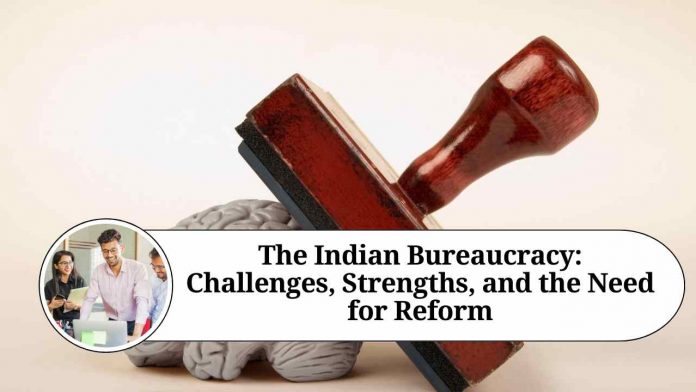Bureaucracy, as a system of government, plays a crucial role in India’s governance. It is responsible for implementing policies, programs, and laws enacted by the government. The Indian bureaucracy has evolved over time, with significant changes being made to its structure, functions, and composition. In this blog, we will explore the role of bureaucracy in India, its strengths and weaknesses, and the challenges it faces.
The Indian bureaucracy is one of the largest in the world, employing millions of people across the country. It is organized hierarchically, with the Indian Administrative Service (IAS) at the top, followed by other civil services such as the Indian Police Service (IPS) and the Indian Foreign Service (IFS). These services are recruited through a competitive examination conducted by the Union Public Service Commission (UPSC). The bureaucracy is also divided into state and central levels, with each state having its own administrative service.
The bureaucracy in India has several strengths. First, it provides continuity in governance and administration, irrespective of changes in government. This continuity ensures that policies and programs initiated by one government are carried forward by the next. Second, it provides a professional and experienced cadre of administrators who are well-trained in various aspects of governance, such as policy formulation, implementation, and evaluation. Third, the bureaucracy serves as a check on the power of elected officials, ensuring that decisions are made based on merit and not political considerations.
However, the Indian bureaucracy also faces several challenges. One of the most significant challenges is the issue of corruption. Corruption is rampant at all levels of the bureaucracy, with public servants often using their positions of power for personal gain. This has led to a loss of public trust in the bureaucracy and a general perception that it is inefficient and corrupt.
Another challenge is the lack of accountability. While the bureaucracy is expected to be accountable to the government and the public, there is often a lack of transparency and an absence of clear performance metrics. This lack of accountability has led to a culture of impunity, where civil servants can get away with poor performance or even corruption without fear of consequences.
The bureaucracy in India is also criticized for being slow and bureaucratic. This is often attributed to the complex and rigid administrative procedures, which can hinder decision-making and slow down the implementation of policies and programs. Additionally, the bureaucratic culture of hierarchy and seniority can stifle innovation and discourage younger civil servants from taking risks.
Despite these challenges, the bureaucracy in India plays a critical role in governance and administration. Over the years, the government has taken several steps to reform the bureaucracy, such as introducing e-governance, simplifying administrative procedures, and promoting transparency and accountability. These reforms are aimed at making the bureaucracy more efficient, effective, and responsive to the needs of the public.
Another issue that the Indian bureaucracy faces is the lack of diversity in its composition. The bureaucracy is still dominated by upper-caste individuals, with lower-caste and minority groups being underrepresented. This lack of diversity can lead to a bias in decision-making and can affect the implementation of policies that are intended to benefit marginalized communities.
The bureaucracy in India also faces a challenge of skill development. The world is moving towards a digital economy, and the Indian bureaucracy needs to keep up with these changes. Many of the civil servants lack the necessary skills and knowledge to deal with issues such as big data, cybersecurity, and artificial intelligence. This lack of skill development can hinder the implementation of digital initiatives and affect the overall efficiency of the bureaucracy.
To address these challenges, the Indian government needs to undertake several reforms. One of the primary areas of reform should be to promote transparency and accountability in the bureaucracy. The government needs to introduce clear performance metrics, reward good performance, and penalize poor performance. This will help create a culture of accountability and discourage corrupt and inefficient practices.
The government also needs to invest in the skill development of the bureaucracy. The civil servants need to be trained in digital technologies, public policy, and management. This will not only improve the efficiency of the bureaucracy but also create a more dynamic and innovative work culture.
Another area of reform should be the diversification of the bureaucracy. The government needs to take steps to increase the representation of lower-caste and minority groups in the civil services. This will help create a more inclusive and diverse bureaucracy that is better equipped to deal with the challenges facing India’s diverse population.
Conclusion
The Indian bureaucracy plays a crucial role in India’s governance and administration. While it faces several challenges, such as corruption, lack of accountability, political interference, and lack of diversity, the government can undertake reforms to address these challenges. Promoting transparency and accountability, investing in skill development, and diversifying the bureaucracy are some of the areas that need urgent attention. Only then can the bureaucracy fulfill its role as an efficient and effective instrument of governance that serves the needs of the Indian people.
Other Related Blogs: Section 144B Income Tax Act
Frequently Asked Questions (FAQs)
Q: What is the bureaucracy in India?
A: The bureaucracy in India is the administrative system that is responsible for implementing policies, programs, and laws enacted by the government. It is a hierarchical system that is organized into various civil services, such as the Indian Administrative Service (IAS), the Indian Police Service (IPS), and the Indian Foreign Service (IFS).
Q: What is the role of the bureaucracy in India?
A: The role of the bureaucracy in India is to provide continuity in governance and administration, implement policies and programs, and serve as a check on the power of elected officials. It is responsible for the day-to-day functioning of the government and plays a crucial role in the implementation of the government’s agenda.
Q: How is the bureaucracy structured in India?
A: The bureaucracy in India is structured hierarchically, with the IAS at the top, followed by other civil services such as the IPS and the IFS. Each state in India has its own administrative service, and there is also a central bureaucracy that is responsible for governing at the national level.
Q: What are the strengths of the Indian bureaucracy?
A: Some of the strengths of the Indian bureaucracy include continuity in governance, professionalism and experience in various aspects of governance, and serving as a check on the power of elected officials. It is also responsible for the implementation of policies and programs and ensuring that decisions are made based on merit and not political considerations.
Q: What are the challenges facing the Indian bureaucracy?
A: The Indian bureaucracy faces several challenges, such as corruption, lack of accountability, political interference, lack of diversity, and bureaucratic culture. These challenges can hinder the implementation of policies and programs and affect the overall efficiency of the bureaucracy.
Q: What reforms are needed to improve the Indian bureaucracy?
A: To improve the Indian bureaucracy, the government needs to promote transparency and accountability, invest in skill development, and diversify the bureaucracy. This will help create a more efficient, effective, and inclusive administrative system that can better serve the needs of the Indian people.




















